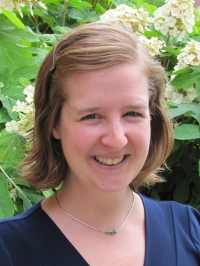Past NIMBioS Postdoctoral Fellow
Elizabeth Hobson
 Dates: June 2014 – May 2016
Dates: June 2014 – May 2016
Personal Website
Project Title: The evolution of social complexity across taxa.
Elizabeth Hobson (Ph.D. Biology, New Mexico State Univ., Las Cruces, 2013) integrates methods related to the evolution of social complexity across taxa. Following her fellowship, Hobson accepted a position as a postdoctoral fellow at the Santa Fe Institute.
LiveScience Profile Q&A with Dr. Hobson: Parrot pecking order hints at humans' social lives
NIMBioS Seminar:
Emergent social properties and the evolution of social complexity
![]()
Feature Stories
Being social: Learning from the behavior of birds – New study elucidates the social world of parrots
Mental math helps monk parakeets find their place in pecking order
Video Interview:
NIMBioS Science Minute: Bird Behavior
Publications while at NIMBioS
Edelaar P, et al. 2015. Shared genetic diversity across the global invasive range of the monk parakeet suggests a common restricted geographic origin and the possibility of convergent selection. Molecular Ecology, 24(9): 2164-2176. [Online]
Hobson EA, DeDeo S. 2015. Social feedback and the emergence of rank in animal society. PLOS Computational Biology. [Online]
Hobson EA, John DJ, Mcintosh TL, Avery ML, Wright TF. 2015. The effect of social context and social scale on the perception of relationships in monk parakeets. Current Zoology, 61(1): 55-69. [PDF]
Hobson EA, Avery ML, Wright TF. 2014. The socioecology of Monk Parakeets: Insights into parrot social complexity. AUK 131(4):756-775. [Online]
Media Coverage
- Pecking order for birdbrains. ScienceLine (22 October 2015)
- Social status and birds: Monk parakeets establish rank based on aggressive behaviors. Nature World News (14 September 2015)
- How do parrots determine the pecking order? They pay attention. BirdChannel (11 September 2015)
- Monk parakeets fight to the top. WUOT's The Method (30 September 2015)
- How monk parakeets pick their battles. Audubon (10 September 2015)
- Successful invasive species has low genetic diversity. The Wildlife Society (6 April 2015)
- Scientists crack the social environment of the bird. National Geographic En Español (23 September 2014)
- New study: Parrots can have "bromances," too. BirdChannel.com (22 September 2014)
- Complex social lives gave parrots big brains. Science (17 September 2014)
NIMBioS
1122 Volunteer Blvd., Suite 106
University of Tennessee
Knoxville,
TN 37996-3410
PH: (865) 974-9334
FAX: (865) 974-9461
Contact NIMBioS


